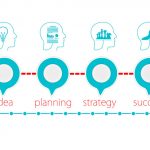Today, more and more people are looking to live a more sustainable lifestyle. This means reducing the number of natural resources used and reducing our carbon footprint. A “carbon footprint” refers to the amount of carbon dioxide produced from certain activities. These activities include traveling (by car or other gasoline/diesel-powered vehicles); how much electricity, heat, and water is used in your home; how much food (particularly red meat) you consume, and how much/how often you go shopping. The United States’ average carbon footprint is about four times that compared to the rest of the world, so here are some ways to reduce it and live a more environmentally friendly lifestyle.

Reduce, Reuse, Recycle
Just about everyone is familiar with these three R’s of living sustainably, but many may not be familiar with the fourth “R”: Review. Review is actually the first step:
- Review: Look at the amount and type of waste you’re producing. Keep track of how much is getting thrown away and how often for a week.
- Reduce: Once you’ve reviewed you can see where you can reduce. You can also reduce the amount of paper and plastic materials you use.
- Reuse: Many of the things we buy can be reused or repurposed. Luckily, this is a strategy widely used by the younger Generations Y and Z.
- Recycle: Once you’ve reviewed, reduced, and/or reused, it’s time to recycle. Keep in mind that items with food/drink residue or are mixed with non-recyclable items cannot be recycled.
Save Water and Energy
Another popular sustainability tip is to turn off lights when you’re not using them, and the same goes for water faucets. If you want to take it a step further and save more of our natural resources (and money) you can invest in smart technology for your home. An example would be smart toilets, which can adjust the flow of water for every flush.
When it comes to saving energy, one of the simplest things you can do is switch to LED light bulbs. They may be more expensive than traditional light bulbs, but they last longer and use less energy. Other ways to make your home more energy efficient include:
- Clean/replace your air filters.
- Turn off/unplug electronics when you’re not using them.
- Use natural light during the day.
- Wash your clothes in cold water.
Switch to an Electric or Hybrid Car
Fortunately, today’s gas-powered cars don’t release as much CO2 (carbon dioxide) as cars did in the past. But, they are still running on gas, meaning that they still produce CO2. Switching to an electric car can completely eliminate CO2 emissions from your car. You may even be eligible for tax benefits when you switch to driving an electric car. See how much car insurance is for electric cars. In addition to not having to worry about gassing up your electric car, you also won’t have to worry about oil changes anymore.
If you’re not ready to switch over to an electric car, you can still reduce your carbon footprint by driving a hybrid (a car that uses both gas and electricity). You can also walk, bike, or participate in rideshare services, either carpooling with friends or using Uber/Lyft.
Conclusion
It’s important to preserve the Earth’s natural resources because most of them are nonrenewable, meaning that once they’re used up they’re gone forever or will take a lifetime (or longer) to replenish. Living unsustainably creates pollution, harming not only animals and the environment, but humans as well. Fortunately, many more people, companies, and organizations are starting to become more eco friendly and making more sustainable choices.
Figuring out your carbon footprint is the first step (review) and then you can decide what is best for you to do from there. Switching to an environmentally friendly lifestyle doesn’t have to happen immediately— in fact, you can be a lot more successful if you make small changes every day.











